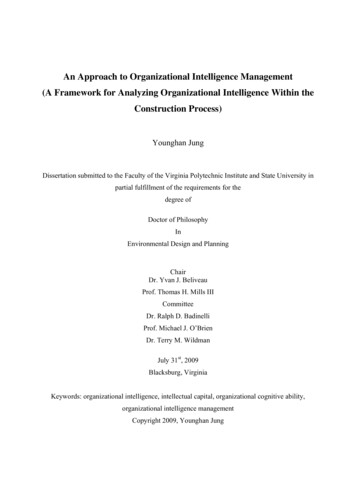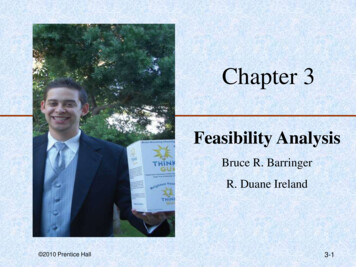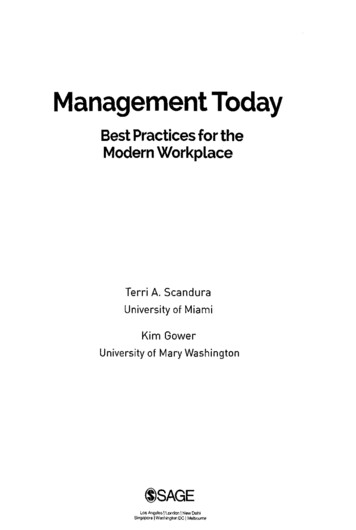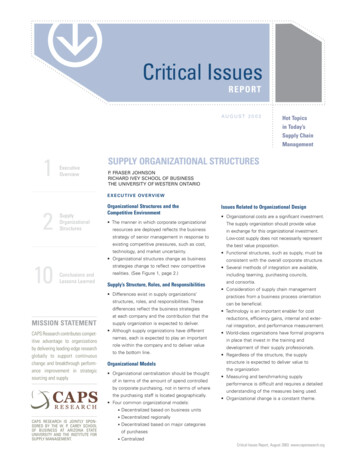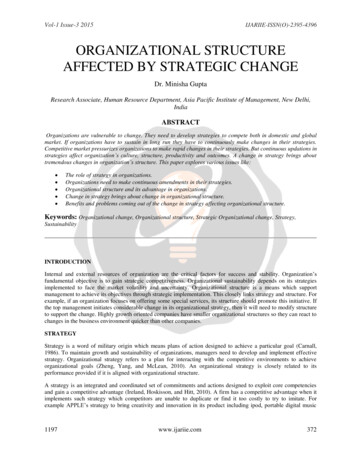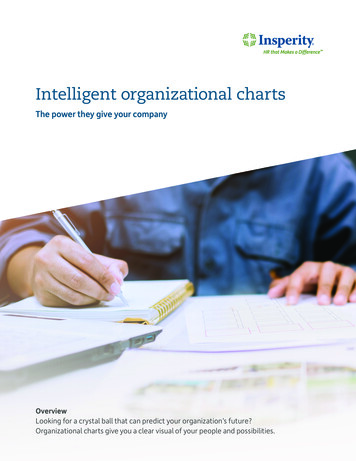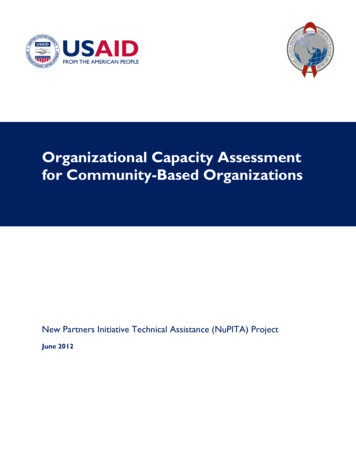
Transcription
Organizational Capacity Assessmentfor Community-Based OrganizationsNew Partners Initiative Technical Assistance (NuPITA) ProjectJune 2012
The New Partners Initiative Technical Assistance (NuPITA) project is funded by the United States Agency forInternational Development (USAID) and implemented by John Snow, Inc. and Initiatives, Inc., contract GHS-I-0007-00002-00.This document is made possible by the generous support of the American people through USAID. The contentsare the responsibility of John Snow, Inc. and do not necessarily reflect the views of USAID or the United StatesGovernment. August 2012 John Snow, Inc.NuPITAJohn Snow, Inc.44 Farnsworth StreetBoston, MA 02210-1211Phone: 617.482.9485www.jsi.com
Organizational Capacity Assessment for Community-Based OrganizationsGoal:The goal of this tool is to assist organizations in assessing the critical elements for effectiveorganizational management, and identifying those areas that need strengthening or further development.Purpose:The OCA tool was designed to enable organizations to define a capacity-building improvement plan,based on self-assessed need. This Organizational Capacity Assessment (OCA) was initially designed tomeasure overall capacity of organizations funded by President’s Emergency Plan for AIDS Relief(PEPFAR) under the New Partners Initiative (NPI). This OCA tool provides organizations with a set ofcriteria to assess their current management capacity to implement quality health programs, to identifykey areas that need strengthening.Although many capacity assessments exist, the structure and process of this tool distinguishes it fromothers. Multi-level and multi-department involvement fosters team building and organizational learning.Inclusion of management, compliance, and program components ensure a holistic understanding of theorganization’s strengths and challenges and the guided self-assessment by skilled facilitators instillsownership on the part of the organization for its improvement plan.The OCA tool assesses technical capacity in seven domains, and each domain has a numberof sub-areas.OCA Domains1. Governance2. Administration3. Human Resources4. Financial Management5. Organizational Management6. Program Management7. Project Performance ManagementUsing This ToolThis Organizational Capacity Assessment tool is designed to enable organizational learning, foster teamsharing, and encourage reflective self-assessment within organizations.Recognizing that organizational development is a process, the use of the OCA tool results in concreteaction plans to provide organizations with a clear organizational development road map. The OCA canbe repeated on an annual basis to monitor the effectiveness of previous actions, evaluate progress incapacity improvement, and identify new areas in need of strengthening.The OCA is an interactive self-assessment process that should bring together staff from all departmentsat implementing organizations, both at headquarters and in the field, for the two- to three-dayassessment.Not intended to be a scientific method, the value of the OCA is in its collaborative, self-assessmentprocess. The framework offers organizations a chance to reflect on their current status againstrecognized best practices. Lively discussions are also an opportunity for management, administration,and program staff to learn how each functions, strengthening the team and reinforcing the interrelatedness of the seven OCA components.Each page of this tool examines one area. A range of examples of services available is provided along acontinuum, from 1-4.
The methodology is a guided self-assessment that encourages active participation. The facilitator andparticipants meet and discuss each area to determine where the organization sits along the continuum ofimplementation. Facilitators ask open-ended, probing questions to encourage group discussion, and takenotes on participant responses. These notes are later used for the action planning.Sample questions which might help the facilitator to probe further into the content areas are presentedon each page.The scores that are arrived at are designed to set priorities for the actions and are not used to judgeperformance. Facilitators use the information from the scoring and rationale sheets to define the issuesand actions. The organization reviews or adjusts the problem statement and builds on the suggestedactions to define action steps, responsibilities, timeframe, and possible technical assistance needs.The ability to identify areas to be addressed will strengthen the organization and in subsequent years,enable it to view improvement and note where progress is still needed.
I.Governance1. Vision, Mission, and Values2. Legal Status3. Governing or Advisory Board4. Leadership and Succession PlanII.Administration1. Organizational Structure2. Operational Policies, Procedures, and Systems3. Filing and Information SystemsIII.Human Resources1. Staffing (levels, hiring, retention)2. Job Descriptions and Staff Supervision3. Personnel Policies4. Compensation (stipends, salaries, and benefits)5. Volunteers and InternsIV.Financial Management1. Financial Policies and Procedures2. Internal Controls3. Financial Documentation and Reporting4. Financial Planning and SustainabilityV.VI.Organizational Management1. Strategic and Operational Planning2. Resource Mobilization3. Communication Strategy: Documentation and Reporting4. Internal Communication Decision-Making5. Stakeholder Involvement6. Knowledge ManagementProgram Management1. Community Involvement2. Project Implementation3. Service Delivery: Standards and Referrals4. Monitoring and Evaluation (M&E) and Quality Assurance (QA)
GovernanceThe objective of this section is to assess the clarity of the organization’s motivation, purpose, andstability by reviewing its guiding principles, structure, and oversight mechanisms.Resources you may wish to refer to in this section:Vision, mission, and/or values statements; by-laws or articles of incorporation; terms of reference forboard members; board meeting minutes; succession plan; certificate of legal registration.1. Vision, Mission, and ValuesRationale: Organizations that have articulated and shared what drives them and toward what they are workingcreate a sense of shared ownership and common commitment to activities. Discuss some or all of the following questions: Does the organization have a vision statement, mission statement, and statement of values? Are the vision and mission used to set priorities? If so, please describe how. Are these statements posted openly in the office or somewhere that staff and visitors can see? Are the statement(s) used in human resource materials (i.e., staff handbooks, orientation materials, jobdescriptions, etc.), organizational brochures, reports, and proposals? Does the organization regularly review the vision and mission statements (for example, in conjunctionwith strategic and/or operational planning)? Come to consensus: Where does the organization fall on this spectrum?Indicate with an ‘O’ where you are now and with an ‘X’ where you want to be at the end of 12 months.
2. Legal StatusRationale: Legal registration, according to the laws of the country, as well as careful adherence to relevant taxand labor laws, enable an organization to gain recognition, perform functions like holding a bank account, andimplement programs accountably. Discuss some or all of the following questions: Is the organization legally registered and is the documentation of current legal registration readilyavailable (or posted) in the office? Are labor laws adhered to? Is this documented in human resource policies? Does the organization comply with the tax codes for both itself and the staff? Does the organization comply with annual statutory requirements, such as audits and other reporting? Does the board review and approve the audit and other statutory reports? Come to consensus: Where does the organization fall on this spectrum?Indicate with an ‘O’ where you are now and with an ‘X’ where you want to be at the end of 12 months.
3. Governing or Advisory BoardRationale: Governing or advisory boards whose members are committed to the organization and bringrelevant knowledge and experience, provide guidance, support, and oversight to the organization’s staff andoperations. Discuss some or all of the following questions: Does the board have clearly defined terms of reference (TOR) that detail its primary duties? Are board roles clearly differentiated from the executive roles? Are there clear and documented criteria for becoming a board member? Are there term limits and a system for electing or approving board members? Does the board meet regularly and document its decisions with minutes? How are board members involved in strategic planning, resource mobilization, and developing andapproving organizational policies and budget and annual financial statements? Come to consensus: Where does the organization fall on this spectrum?Indicate with an ‘O’ where you are now and with an ‘X’ where you want to be at the end of 12 months.
4. Leadership and Succession PlanRationale: Over-reliance on a single person, such as the executive director (ED) or founder puts anorganization at risk of failing in the absence of that person. Discuss some or all of the following questions: Is there a deputy or other staff/board member who can fulfill the duties of the ED if he or she is absentfor short or long periods? Does the organization support capacity-building to ensure that others are able to take on or assist withthe key functions of the organization’s leadership (fund-raising, operations, and program quality)? Is there a documented succession plan for the ED? Do people other than the ED have contacts and relationships with key donors and stakeholders? Come to consensus: Where does the organization fall on this spectrum?Indicate with an ‘O’ where you are now and with an ‘X’ where you want to be at the end of 12 months.
I. AdministrationThe objective of this section is to assess the organization’s capacity to develop and use key policies,procedures and systems to manage its general operations and functions.Resources you may wish to refer to in this section:Policy and procedures manuals; samples of administrative forms.1. Organizational StructureRationale: An organization whose structure is in line with its mission, goals, and programs and has systems inplace to ensure coordination among departments and functions can improve its efficiency and effectiveness Discuss some or all of the following questions:Is the organizational and reporting structure clearly documented and disseminated?Is there an organogram or other document outlining supervisory and staff responsibilities?How do departments communicate with each other and what are their functions?Does the current structure adequately support the departments/functions? Come to consensus: Where does the organization fall on this spectrum?Indicate with an ‘O’ where you are now and with an ‘X’ where you want to be at the end of 12 months.
2. Operational Policies, Procedures, and SystemsRationale: Clear guidance for organizational operational procedures enables better adherence to anorganization’s rules and regulations.Discuss some or all of the following questions:Are there written organization policies and procedures that support operational needs (e.g., travel,procurement, fixed assets, security, etc.)?Are they presented so financial and non-financial staff can benefit from the guidance?Are staff trained on the details and purpose of the policies and procedures?How is compliance with the systems monitored?Are the existing procedures/policies reviewed?Are procedures in line with external regulations?Come to consensus: Where does the organization fall on this spectrum?Indicate with an ‘O’ where you are now and with an ‘X’ where you want to be at the end of 12 months.
3. Filing and Information SystemsRationale: An organization with a functional information system can provide efficient support to operations andprograms.Discuss some or all of the following questions:Is there a general filing system that documents how and where information is stored?Is someone responsible for the system?Is the information adequate to support operations and programs?Does the system include guidance to allow the organization to manage information on best practices andother program support?Is the system structure communicated to all staff? Come to consensus: Where does the organization fall on this spectrum?Indicate with an ‘O’ where you are now and with an ‘X’ where you want to be at the end of 12 months.
II. Human ResourcesThe objective of this section is to assess the organization’s ability to maintain a satisfied and skilledstaff/volunteer workforce and to manage operations and staff time in order to implement quality programs.Resources you may wish to refer to in this section:Staffing plan, recruitment policy and guidelines, personnel manual, job descriptions, volunteer/internpolicy and compensation policy, vacancy and turnover data, retention policies, performance appraisals.1. Staffing (levels, hiring, retention)Rationale: Organizations with equitable and consistently applied human resources policies that address salary,recruitment, and retention can more effectively maintain appropriately skilled personnel, including both paid staffand volunteers. Discuss some or all of the following questions: Are there written and transparent recruitment guidelines that include job descriptions and qualifications,announcements, short-listing, interviewing, reference and salary history review, and employeeagreements? Is there designated HR staff and are they trained in how to use the guidelines? Are there approaches for retaining staff, including benefits, recognition, career advancement, and exitinterviews? Is there a documented staffing plan and active review of staffing status? Are positions filled with the people with the right qualifications, skills, and experience? Are current positions filled? Is data on vacancy and turnovers kept and reviewed? Come to consensus: Where does the organization fall on this spectrum?
Indicate with an ‘O’ where you are now and with an ‘X’ where you want to be at the end of 12 months.2. Job Descriptions and Staff SupervisionRationale: Appropriate job descriptions (JDs) ensure that staff roles and responsibilities are clearly defined andunderstood and help supervisors review and improve performance against expectations Discuss some or all of the following questions: Are there templates for job descriptions that list title, job duties, reporting requirements, qualifications,and skills? Are JDs filed and updated as needed? Is there a documented supervisory plan? Is staff aware of the structure? Are supervisors aware of their responsibilities and trained to be supportive? Are supervisor findings documented and discussed? Are performance appraisals conducted? How often? Come to consensus: Where does the organization fall on this spectrum?Indicate with an ‘O’ where you are now and with an ‘X’ where you want to be at the end of 12 months.3. Personnel PoliciesRationale: Personnel policies understood by all staff members provide clear rules and regulations that governhow staff, volunteers, and other organizational representatives are expected to act and what they can expectfrom the organization. Discuss some or all of the following questions: Do we have documented policies that address the following areas?o work schedule and time management
o employee compensation (salary) and benefitso employee conducto types of leave and how to request themo performance reviewso grievances and disciplinary procedureso ending employment (resignation/termination)o various administrative procedureso HIV in the workplace Are these policies collected in a personnel manual that all staff receives? Do staff sign to confirm thatthey have received the personnel manual? How and how often is the personnel manual updated? Come to consensus: Where does the organization fall on this spectrum?Indicate with an ‘O’ where you are now and with an ‘X’ where you want to be at the end of 12 months.4. Compensation (stipends, salaries, and benefits)Rationale: Fair and equitable distribution of stipends, salaries, and benefits can improve staff retention andmorale. Discuss some or all of the following questions: How are salaries determined? Is salary history, salary scale, or an alternative system used andunderstood by staff? Is salary history verified and determination of salary documented and filed? If pay grades and ranges are used, are they documented and applied to all staff? Are pay grades and ranges updated annually? Are pay increases and performance reviews coordinated? Are employee benefits equitably applied? Are benefits documented and are staff aware of them? Do staff salaries and employee benefits conform to national labor laws?
If stipends are provided are they consistent and timely? Come to consensus: Where does the organization fall on this spectrum?Indicate with an ‘O’ where you are now and with an ‘X’ where you want to be at the end of 12 months.5. Volunteers and InternsRationale: Organizations that provide field and office-based volunteers and interns with clear tasks, training,supervision, and recognition tend to have less turnover and receive significant contributions to the organization. Discuss some or all of the following questions: Is there a documented policy for recruiting, selecting, engaging, and managing/supervising volunteers andinterns? Is training and orientation provided regularly? Are volunteers given job descriptions? Are they provided with performance standards? Are these used to assess performance? How is supervision provided? Do they receive financial or non-financial recognition/compensation? Come to consensus: Where does the organization fall on this spectrum?
Indicate with an ‘O’ where you are now and with an ‘X’ where you want to be at the end of 12 months.
III.Financial ManagementThe objective of this section is to assess the quality of the organization’s financial system and policiesand procedures and the staff’s knowledge of the system.Resources you may wish to refer to in this section:Financial manual, accounting journals, chart of accounts, payment vouchers, staff training plan, signatorypolicy/authority matrix, budget, budget tracking sheet, financial reports, strategic plan.1. Financial Policies and ProceduresRationale: Having clear, well-documented policies and procedures for financial management that areunderstood and used by staff members allows an organization to function transparently and promotes integrityand accountability. Discuss some or all of the following questions: What type of accounting system does the organization use? How is the system implemented? Is theorganization using accounting software? Which financial procedures are documented? How are financial procedures developed and approved?How often are the financial procedures formally reviewed/updated? What is included in the financialpolicies and procedures? Do they include:o A signatory/authority matrix (who can do what)? Does it include authorization limits?o Who are the organization’s check signatories?o Budgeting and reporting requirements?o Policies regarding receipts (definition, recording)?o Requirements for documenting expenses/payments and income/receipts (supportingdocumentation and retention period)?o Managing bank accounts in the organization’s name?o Managing petty cash (who can spend, types of items, limit)?o Monthly reconciliation of all cash accounts?o Policies and procedures for handling potential fraud? How are staff members oriented/trained in the procedures? How often? Does the organization have separate accounts for separate programs? Does the organization use codesto assign transactions to a specific project/donor? Is there cashbook (or bank journal) completed in ink used for each bank account? How are account balances kept? Are all payments and receipts recorded in the organization’sbookkeeping system? How are transactions in the accounting system linked to supportingdocumentation? What systems ensure compliance with financial procedures? At the end of the fiscal year how areaccruals recorded? Come to consensus: Where does the organization fall on this spectrum?
Indicate with an ‘O’ where you are now and with an ‘X’ where you want to be at the end of 12 months.2. Internal ControlsRationale: Strong internal controls help an organization safeguard its assets, manage internal risks, and ensureaccurate and reliable financial accounting and reporting. Discuss some or all of the following questions: Are there written policies on internal controls that are regularly reviewed and updated, and staff aretrained on? Do the controls guide the segregation of duties among staff involved in financial management? Do multiple people review and approve payments and financial reports? How is petty cash managed? Is there a safe or other secure location for storing cash and checkbooks? Are there a limited and knownset of people who can access the contents? How does the organization periodically assess its financial risks? Is there a documented procedure for handling possible instances of fraud or theft? Come to consensus: Where does the organization fall on this spectrum?
Indicate with an ‘O’ where you are now and with an ‘X’ where you want to be at the end of 12 months.3. Financial Documentation and ReportingRationale: Keeping accurate and up-to-date financial records enables an organization to track resources,monitor its financial status, and prepare accurate financial reports for donors, stakeholders, and auditors in atimely fashion. Discuss some or all of the following questions: Are there written guidelines and procedures for documenting all types of financial transactions? How often are these guidelines reviewed and updated? What is the process for this? Is the organization’s financial documentation up-to-date? Are financial files kept neatly, organized, and secure? Are there procedures for preparing and disseminating financial reports? Does the organization adhere to relevant legal requirements on financial reporting, such as audits? Who in the organization prepares, reviews, and approves financial reports that are shared with donorsand other stakeholders? Come to consensus: Where does the organization fall on this spectrum?
Indicate with an ‘O’ where you are now and with an ‘X’ where you want to be at the end of 12 months.4. Financial Planning and SustainabilityRationale: Financial planning and monitoring that aligns with program planning and monitoring enables anorganization to implement planned activities and demonstrate accountability to resource providers, which buildstheir confidence in the organization and makes them more likely to continue supporting the organization. Discuss some or all of the following questions: Does the organization have a master budget that includes operating and overhead costs as well asproject activities? How is it developed? How are budgets reviewed and approved? Are they frequentlyupdated? Are project budgets developed during activity planning? Does the organization have a documented resource mobilization strategy? How does it relate to thestrategic plan? Does the organization have income-generating activities or other sources of unrestricted funding? Does the organization have a cash flow that allows it to meet its financial obligations? Is the organizationin debt? Come to consensus: Where does the organization fall on this spectrum?
Indicate with an ‘O’ where you are now and with an ‘X’ where you want to be at the end of 12 months.
IV.Organizational ManagementThe objective of this section is to assess the organization’s planning, management of external relations,means of identifying and capitalizing on new resources, and decision-making policies.Resources you may wish to refer to in this section:Strategic plan, operational plan, stakeholder list and analysis, resource mobilization plan.1. Strategic and Operational PlanRationale: Having a strategic plan helps an organization realize its mission and goals with a shared vision, longterm and costed plan, and annual operational plans.Discuss some or all of the following questions: Does the organization have a current strategic plan?Did staff and stakeholders participate in its development?How long a period of time does it cover?Does it include measurable objectives, resource needs, and costs? How will it be funded?Is the strategic plan used to guide annual operational planning?Is the operational plan linked to the budget?How are the plans reviewed and monitored? Come to consensus: Where does the organization fall on this spectrum?Indicate with an ‘O’ where you are now and with an ‘X’ where you want to be at the end of 12 months.
2. Resource MobilizationRationale: A resource mobilization plan that ties to the strategic plan’s budget enables the organization toprioritize strategies for identifying and approaching appropriate donorsDiscuss some or all of the following questions:Does the organization have a strategic plan that identifies resource needs?Have potential funders or donors been identified?Is there a strategy for obtaining funds and resources to support program priorities?Do staff or board members in the organization have the skills needed for proposal writing andcommunication strategy implementation? Does the organization have income-generating activities or other sources of funds that are not tiedto a single program but can support general operations? Does the organization partner with other organizations to maximize input and minimize cost? Come to consensus: Where does the organization fall on this spectrum?Indicate with an ‘O’ where you are now and with an ‘X’ where you want to be at the end of 12 months.3. Communication Strategy: Documentation and ReportingRationale: Having policies on documentation and reporting enables the organization to build institutionalmemory. Disseminating factual and analytical reporting contributes to building a reputation that can attractdonors and partners, especially when recognized branding is used.Discuss some or all of the following questions:Is there a policy that describes what should be documented and how? Are there templates to enableuniformity?Is there a filing system (soft (electronic) and/or hard) to ensure easy access to documentation?Are reports tagged for sharing? For example, is relevant M&E data shared with organization, community,stakeholders, success stories, board reports, donor reports?
Is there a plan for promoting successes, etc. to donors, other organizations, stakeholders and/orbeneficiaries?Does the organization have an up-to-date website or brochure to provide information and promote itsefforts?Does the organization have a branding or tag line and a policy for how and when to use it? Is it linked toyour mission? Has it been tested for recognition?Are staff trained on how to follow the branding policy? Come to consensus: Where does the organization fall on this spectrum?Indicate with an ‘O’ where you are now and with an ‘X’ where you want to be at the end of 12 months.4. Internal Communication and Decision-MakingRationale: How an organization sets up processes and structures for open communication and decision-makingimpacts motivation, innovation, and ownership.Discuss some or all of the following questions:Are current management and staff accepting of different communication styles and flows (formal,information, face-to-face, and confidential)?How often are staff meetings held? What other mechanisms are there for assisting internal communication(e.g. internal newsletters, memos, social events)? Are they adequate?Does management encourage and incorporate staff ideas and input?Are staff comfortable raising challenging issues using the existing communication mechanisms?Do staff feel they are involved in the decision-making? Are new decisions communicated to staff?Are staff ideas sought and incorporated into decision-making?Is there a strategy for dealing with conflicts should they emerge? Come to consensus: Where does the organization fall on this spectrum?
Indicate with an ‘O’ where you are now and with an ‘X’ where you want to be at the end of 12 months.5. Stakeholder InvolvementRationale: Identifying and nurturing relationships with relevant stakeholders can facilitate programcoordination, partnering, and resource sharing.Discuss some or all of the following questions: Does the organization have a clear definition of stakeholders? Does the organization have complete and up-to-date information about all stakeholders working inthe same geographic and/or technical areas? Does the organization have collaborative agreements with relevant stakeholders? Does the organization know stakeholder’s approaches for addressing gender and culture issues? Does the organization plan with and update relevant stakeholders (community, donors, districts,etc.) on progress? Come to consensus: Where does the organization fall on this spectrum?
Indicate with an ‘O’ where you are now and with an ‘X’ where you want to be at the end of 12 months.6. Knowledge ManagementRationale: Systems for sharing knowledge, technical expertise, and best practices among staff leads to efficientadaptation of new practices, stronger programs, and more competent staff.Discuss some or all of the following questions: Do you have relationships with appropriate/relevant technical organizations (government, academic,or public) to build your knowledge base? Do you have a process for sharing new information/practices among staff? Do you have process for analyzing and ident
organization’s strengths and challenges and the guided self-assessment by skilled facilitators instills ownership on the part of the organization for its improvement plan. The OCA tool assesses technical capacity in seven domains, and each domain has a number of sub-areas. OCA Domains . 1.




